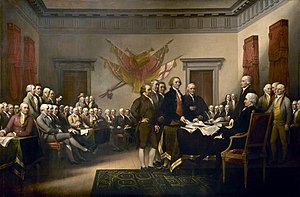Declaration of Independence (Trumbull)
| The Declaration of Independence | |
|---|---|
 |
|
| Artist | John Trumbull |
| Year | commissioned 1817; purchased 1819; 1826 placed in the Rotunda |
| Medium | Oil-on-canvas |
| Dimensions | 3.7 m × 5.5 m (12 ft × 18 ft) |
| Location | U.S. Capitol, Washington, D.C., U.S. |
The painting Declaration of Independence is a 12-by-18-foot (3.7 by 5.5 m) oil-on-canvas work by American John Trumbull; it depicts the presentation of the of the Declaration of Independence to Congress. It was based on a much smaller version of the same scene, presently held by the Yale University Art Gallery. Trumbull painted many of the figures in the picture from life, and visited Independence Hall to depict the chamber where the Second Continental Congress met. The oil-on-canvas work was commissioned in 1817, purchased in 1819, and placed in the United States Capitol rotunda in 1826.
The painting is sometimes incorrectly described as the signing of the Declaration of Independence. The painting shows the five-man drafting committee presenting their draft of the Declaration to the Congress, an event that took place on June 28, 1776, and not the signing of the document, which took place later.
The painting shows 42 of the 56 signers of the Declaration; Trumbull originally intended to include all 56 signers but was unable to obtain likenesses for all of them. He also depicted several participants in the debate who did not sign the document, including John Dickinson, who declined to sign. Trumbull had no portrait of Benjamin Harrison V to work with, but his son Benjamin Harrison VI was said to resemble his father, so Trumbull painted him instead. As the Declaration was debated and signed over a period of time when membership in Congress changed, the men featured in the painting never were in the same room at the same time.
Thomas Jefferson seems to be stepping on John Adams' foot in the painting, which many thought was supposed to symbolize their relationship as political enemies. However, upon closer examination of the painting, it can be seen that their feet are merely close together. This part of the image was correctly depicted on the two-dollar bill version.
...
Wikipedia
